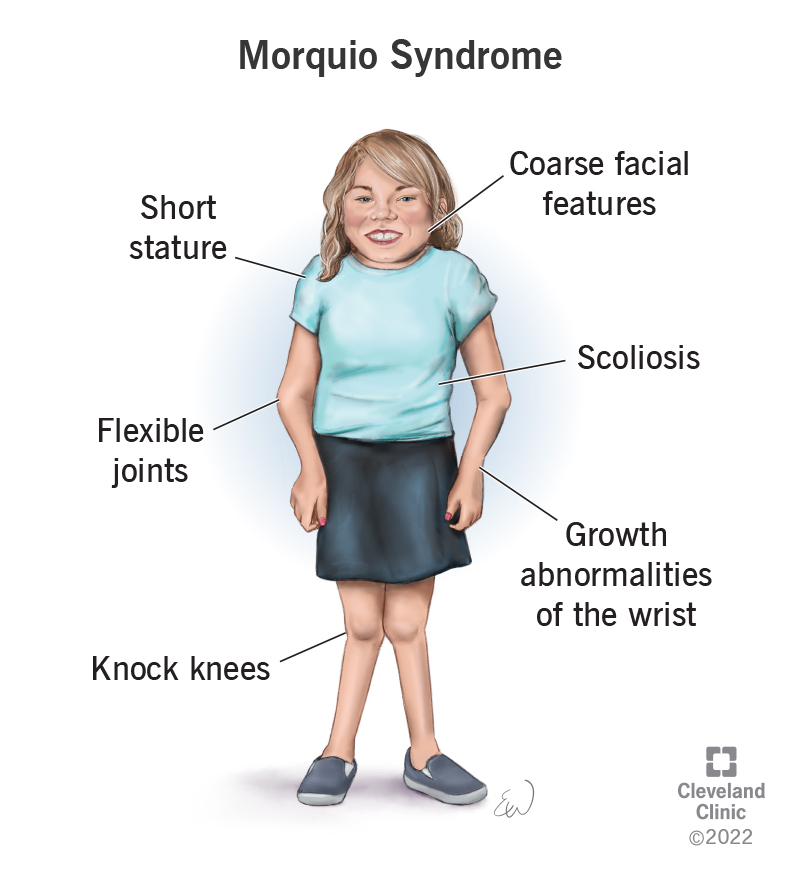Morquio syndrome, or mucopolysaccharidosis IV (MPS IV), is a genetic condition that causes symptoms like bone growth abnormalities. Symptoms occur because enzymes can’t break down sugar molecules (glycosaminoglycans). The condition progressively gets worse over time. There’s no cure for Morquio syndrome but treatment can manage symptoms.
Advertisement
Cleveland Clinic is a non-profit academic medical center. Advertising on our site helps support our mission. We do not endorse non-Cleveland Clinic products or services. Policy

Morquio syndrome, also known as mucopolysaccharidosis IV (MPS IV), is a condition that causes bone growth abnormalities and symptoms throughout your body that worsen over time. This means it’s progressive. The condition is genetic. It occurs when large sugar molecules (glycosaminoglycans or GAGs, formerly called mucopolysaccharides) can’t be broken down due to not having enough enzyme activity.
Advertisement
Cleveland Clinic is a non-profit academic medical center. Advertising on our site helps support our mission. We do not endorse non-Cleveland Clinic products or services. Policy
There are two types of Morquio syndrome that have similar symptoms but a different genetic cause:
Both types have different treatment options, so identifying the type is important.
Morquio syndrome affects an estimated 1 in 200,000 to 300,000 people in the United States. About 95% of cases are type A.
Morquio syndrome symptoms appear from infancy to early childhood and increase in severity over time. Symptoms can affect the skeleton and include:
Symptoms can also affect other parts of the body and cause:
Severe symptoms of Morquio syndrome can be life-threatening and include:
Advertisement
Morquio syndrome doesn’t affect a person’s intelligence.
Having two genetic changes (mutations) in either the GALNS (type A) gene or the GLB1 (type B) genes causes Morquio syndrome. These genes produce enzymes that break down large sugar molecules called glycosaminoglycans (GAGs) or mucopolysaccharides.
When mutations target the GALNS or GLB1 genes, your enzymes don’t have the instructions they need to do their job. This means they have little to no activity. As a result, sugar molecules accumulate in your lysosomes. These are places inside of cells that recycle or break down molecules. For this reason, Morquio syndrome is also known as a lysosomal storage disorder.
The accumulation of sugar molecules targets tissues and organs but mostly affects your bones, where you’ll experience symptoms.
Morquio syndrome can affect anyone since it’s a genetic condition. You can inherit the condition from genes you receive from both of your parents during conception (autosomal recessive). If you inherit the condition, your parents are carriers of the gene but don’t experience symptoms of the condition.
A diagnosis usually begins when symptoms become apparent, usually during early childhood. Your child’s provider will perform a physical examination and order an X-ray to look closely at their bones. Your child’s provider will also order additional tests like:
Treatment for Morquio syndrome addresses symptoms of the condition since there’s no cure. Treatment could include:
At first, symptoms of Morqio syndrome may be mild, but you can expect them to get worse as your child gets older. Treatment can help to keep your child more comfortable and may prevent life-threatening outcomes.
The life expectancy of people diagnosed with Morquio syndrome varies based on the severity of the condition. Your child’s healthcare provider will give you their outlook based on their situation. Symptoms that cause early death include breathing difficulties and a compressed spinal cord.
Advertisement
Children with severe symptoms could have a life expectancy into adolescence. People who have mild symptoms have a life expectancy into middle adulthood, up until age 60.
There’s no way to prevent Morquio syndrome since it’s a genetic condition. Reach out to your healthcare provider about genetic testing to understand your risk of having a child with a genetic condition.
Symptoms that affect the spinal cord and airways are most severe and require immediate attention. Visit the emergency room if your child has trouble breathing or can’t move a part of their body (paralysis).
Always monitor your child’s symptoms, especially after surgery to check for infections. Contact your child’s provider if they experience pain, swelling or a clear to yellow fluid drains from their surgical site.
You may want to consider asking your child’s provider:
It’s difficult to hear that your child has a genetic condition that could give them a shortened life expectancy. You’ll need to offer them continuous love and support every day. Since this condition affects their bones, it may be difficult for your child to walk and play with others their age. Using assisted mobility devices offers your child the freedom to participate in childhood activities.
Advertisement
Reach out to your provider if you notice your child misses developmental milestones related to their vision or hearing to prevent them from falling behind in school. Visit the emergency room if your child has trouble breathing or is unable to use part of their body.
Advertisement
As your child grows, you need healthcare providers by your side to guide you through each step. Cleveland Clinic Children’s is there with care you can trust.

Last reviewed on 04/22/2024.
Learn more about the Health Library and our editorial process.